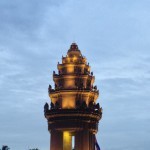Lisa Niver's Blog: We Said Go Travel, page 465
September 27, 2013
Mexico: The Different Cancun
Enjoy this post on The Different Cancún: Another Side of Paradise from our Travel Writing Contest Judge, Richard Bangs. Share your story of where you find awe and feel gratitude! $1,000usd in cash prizes!
The pearls of praise for the place called Cancún often sheen to dizzying effect. There is no refuting that this stretch of soft sand caressing the warm, clear waters of the Caribbean is the acreage of paradise, a dazzling tropical necklace that evokes powerful, even passionate imagery. The acclaim is true… the beaches, the resorts, the sun, the sports, the shopping, the clubs and bars are laced in lavish profusion, and all so close to a host of gateway cities in the U.S. that it takes less time to reach than traveling to the Mediterranean or Hawaii or Bali or Fiji or Tahiti, or any other retreat that pronounces itself paradise.
The empyrean lure of Cancún is deeply implanted in Western Tradition, with roots in both classical and biblical soil. Since the beginnings of modern maps, cartographers have shown the authentic location of paradise as between the Tropics of Cancer and Capricorn (Cancún is at 21.16 degree north, comfortably in that range). The romancers of the Age of Discovery had little difficulty in placing Elysium in the exotic lands that curl through the tropic zones, which they would people variously with noble savage, lost tribe, or superior human beings. The early explorers, both globe-trotters and narrators — Columbus among them — gave open support to this kind of thinking. Today, Cancún is the summerland of the Americas, a cabinet of the Caribbean, the ark of México, and to millions of travelers, paradise found.
But paradise is a relative conceit, and while there are many who seek the tans and the umbrella drinks and the dance music, there are others, and I include myself, who are seduced by the more vertical escapes, ones with forward motion, adventure, but yes, paired with great food.
So, on the advice of a friend, I set out to find the different Cancún, to fathom the allure of some of its secrets, murmurs that float in the back pages of the brochures, and below the fold of websites. And most pleasantly surprised I was.
After a short flight from Los Angeles I descend over a green tapestry of dense jungle that twines inland for miles, silent, motionless, stretching into another world. There, now, is the island of Cancún, a powder-sand scimitar separated by the Nichupte lagoon and the deep blue Caribbean.
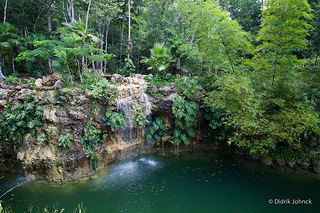 I find my way along Boulevard Kukulcan, named for the Mayan Plumed Serpent god, down through the hotel zone, the 17-mile stretch of beach that hosts some 30,000 rooms. I check-in, freshen up and surrender to some ceviche, a margarita and a dip. Then, an early sleep, to ready for the week.
I find my way along Boulevard Kukulcan, named for the Mayan Plumed Serpent god, down through the hotel zone, the 17-mile stretch of beach that hosts some 30,000 rooms. I check-in, freshen up and surrender to some ceviche, a margarita and a dip. Then, an early sleep, to ready for the week.
In the cool shadows of the morning I board a small bus, and down a flat highway we wheel to the Xenotes Oasis Maya, a new park that offers up a series of adventures in four cavernous flavors. The Mayans, in this rainforest, developed one of the most highly-developed civilizations in pre-
Columbian America. And they did it with a complete lack of surface water. How? The cenotes, limestone sinkholes that hold the flow from underground rivers, permanent fresh water that made life possible for the original inhabitants of the Yucatán Peninsula. The word “cenote” originates from the Maya “dzonot” meaning “well.” The word “Yucatán” originates, legend has it, when the Conquistadors asked the Mayans what they called their land. They replied, “Yucatán,” which means “We don’t understand you.”
It’s an edenic trundle into the park, and along the way Tania Solis Sanchez, our guide, leads us in a Mayan prayer to Aluxes, legendary guardians of the jungle, asking permission before entering their domains. She says the name of each of the cenotes is associated with the four elements of Nature and their Mayan origins: K’áak or Fire; Ha’ or Water; Iik’ or Wind; and Lu’um or Earth. Is it a coincidence, then, that Earth, Wind & Fire is playing at my hotel this week?
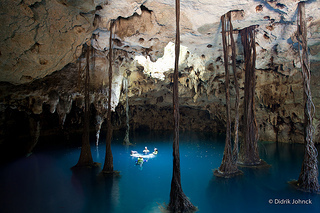 We park at the narrow mouth of the first cenote, and I lean cautiously over the edge, and gawk. One doesn’t have to be Mayan to feel the flush of wonder at this site. It’s more like a miniature Grand Canyon than a well, with what looks like a quiet river curling through. The misty diadem of a waterfall spills off the opposite edge of the canyon. Fellow explorers are padding inner tubes and inflatable boats; laughing and leaping from ledges into the cool, clear water, where the sounds of splashes ricochet up the walls.
We park at the narrow mouth of the first cenote, and I lean cautiously over the edge, and gawk. One doesn’t have to be Mayan to feel the flush of wonder at this site. It’s more like a miniature Grand Canyon than a well, with what looks like a quiet river curling through. The misty diadem of a waterfall spills off the opposite edge of the canyon. Fellow explorers are padding inner tubes and inflatable boats; laughing and leaping from ledges into the cool, clear water, where the sounds of splashes ricochet up the walls.
At the second cenote a couple of ziplines stretch from the forest into a vault of water, so we can fly like winged gods into the gallery. At the third, we snorkel the clear pool (where feet are nibbled with little fishy kisses… they should use this in a spa), and follow the flow into an underworld passage; and in the finale, we rappel down the mouth into an amphitheater that seems supported by vines, stalagmites, and spears of light. It seems a place where legends could be true, such as the stories that Maya practiced ritual sacrifice in these chambers; or that these pure waters are the fountain of youth, which seems entirely possible when our guide, who looks 23, claims to be 63. I take one last baptismal dip, just in case it’s true.
It’s all topped off with a glam picnic under a palapa in the jungle, fluttering with butterflies, bounded by iguanas, and featuring minestrone soup, artisan bread, deli meats, fine cheeses, water, soda, beer and wine.
The next morning, in the first blush of pink light, I take the 20-minute public ferry to Isla Mujeres, the legendary “Island of Women,” crossing beneath the supple wings of frigate birds, through a warm waft of wind to a dock bounded by small buildings and wooden-roofed fishing boats colored in weathered shades.
Perhaps the most evocative question looms with the landing: why is this called the Island of Women? Despite its redolent name, it is not a gynarchy. There are a few origin theories, of course, one of which has a pirate from Cuba landing and finding only females on the island, not knowing their husbands were out at sea fishing. The most popular notion has Francisco Hernández de Córdoba, commander of the first Spanish expedition, setting foot in 1517, and finding several small figurines of the Mayan fertility goddess Ix Chel.
Fertility is still a goddess today, but more in the realm of couples seeking the ideal wedding location, or honeymoon, or romantic get-away. Nothing here is inconceivable.
People come to Cancún to get away from the stress of big cities; people come to Isla Mujeres to get away from the crush of Cancún. It still holds onto some of that old, small-fishing-village, kick-back-in-the-hammock México character. Here, it’s always — Hammock Time.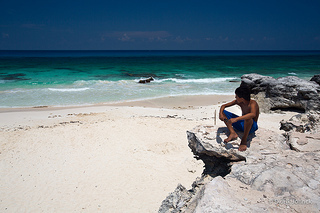
I rent a golf cart, the conveyance of choice, put peddle to metal and roar along at 10 miles an hour, flying over the many topes, or speed bumps, until a few minutes later I arrive at Playa Norte, a stunningly beautiful white beach that looks from a Corona commercial. I wade in up to my knees, and drop a quarter in the water. It’s so clear I can read the word “Liberty” above Washington’s visage without bending over.
I take octopus tacos, homemade guacamole and a chili-infused margarita at Capitan Dulche, a beach club in the shadow of a 100-year-old beached pirate ship. There are parrots, metal sculptures of musicians frozen in the act; a museum that celebrates local history from Mayans to buccaneers to Jacques Cousteau to the only Mexican aboard the Titanic; and the best bathrooms on the island.
After the lazy lunch I go nowhere fast; and do nothing firmly for the rest of the afternoon. That is how Isla Mujeres rolls.
In the bath of early morning light I board a boat heading out to find the whale sharks. We motor miles out into the open sea, well beyond the Great Maya Reef, second largest barrier reef in the world. Finally, beyond any trace of land, we see the notorious dorsal fins cutting through the surface. But, rather than retreat to safety in the middle of the boat, we don wetsuits, adjust masks, and slip over the side into a sea stirred gently by circling fins. Immediately I come face-to-face with the gaping maw of a 30-foot-long shark, sprouting upwards as though about to swallow me whole, man-brunch. I mumble something panicky into my mask, madly flip my flippers to get out of the way, and the giant glides past, body rippled and dotted, open-mouthed surging to the surface. The world’s largest fish, thankfully, feeds exclusively on plankton.
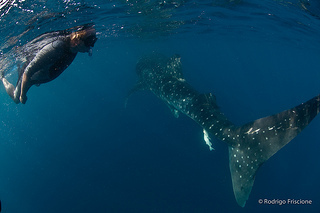 First, there was one. Then another. And another. Quite soon I’m surrounded by a score or more of the gentle beasts, each with a mouth the size of a steam shovel. Some sashay sideways; others go “botella, ” rising vertically to the surface to gulp down fish eggs and bubbles. Gills flow like ribbons; their bodies showcase Jackson Pollack-like splatter spots, where little cleaner fish cling. Calmer now, I hear only the whooshing of the water around me, my amplified breathing through the snorkel, and the sound of awe.
First, there was one. Then another. And another. Quite soon I’m surrounded by a score or more of the gentle beasts, each with a mouth the size of a steam shovel. Some sashay sideways; others go “botella, ” rising vertically to the surface to gulp down fish eggs and bubbles. Gills flow like ribbons; their bodies showcase Jackson Pollack-like splatter spots, where little cleaner fish cling. Calmer now, I hear only the whooshing of the water around me, my amplified breathing through the snorkel, and the sound of awe.
Rodrigo Friscione, our guide, is part of the family-owned Solo Buceo tour company, the first to be granted a permit to guide whale shark encounters back in 1998. He says this featureless spot features the largest aggregation of whale sharks in the world. “And you don’t even need to know how to swim to see them. Just put on a life jacket, stick your face in the water and watch the most beautiful creatures in the sea slowly swim by.”
That evening, back at the hotel, I belly up to the bar and ask barkeep, Fabian Barba, how to make the perfect margarita. He outlines his choice of ingredients: triple sec, lime juice, agave nectar, and when he gets to the part about the tequila, says: “It has to be a great tequila.” He suggests I check out the Tequila Herradura Sensorial Museum down the road. I remember when tequila was considered a cheap college drink, but wow have things changed… now it is dignified as posh liquescent art. Docent Lina Lopez transports me back to a bygone hacienda, festooned with blue agave, and there demonstrates the traditional artisanal method of crafting México’s national spirit. Then we retire to the sipping room, and sample some exquisite aromas and flavors, as though sipping the world’s finest cognac.
Under the ruddy light of early day I head over to the Moon Palace Golf & Spa Resort, which has the grounds and geometries worthy of a Mayan prince.
I’m not a great golfer, though enjoy the challenge. But here is a course that has a few challenges I’ve not encountered before… iguanas, coatis, and crocodiles. Besides the omnipresent jungle and mangroves, which frame the wide playing areas, the main feature is the extensive use of water hazards, and in those ponds and lakes swims some swarthy reptiles. It’s a Jack Nicholas signature course, so I know it’s exquisitely designed with no real danger of man-eaters, except perhaps at the bar, but just knowing they are there lends an extra thrill to the 27-hole-course.
After duffing about for the morning, I need a massage, so head over to the uber-elegant Le Blanc Spa, thick with bamboo gardens and tropical wood interiors. As the spa concierge lays a warm towel on my neck, the music and aroma-therapy envelopes, and I dissolve into something very low on the food chain. Sometime later, maybe days, I ooze over to the sauna with eucalyptus essence and soak in an hibiscus-festooned whirlpool. Then a pressure shower. Then, for the denouement: the fish spa. The spa imported garra rufa (or “doctor fish”), a species native to the Middle East that feed on dead human skin. They are then released in little tanks at the bottom of a massage chair. It tickles like the soft fishy kisses of the cenotes experience. According to my fishing guide, the pez treatments release fatigue, increase blood circulation, and aid in relaxation. For me, it prompts uncontrollable giggling, and a hankering for sea food.
So, that night I head over to Julia Mia, an inspired Mexican restaurant in downtown Cancún. It turns out Julia, the owner, is at the place, sipping tequila, and sprinkling her magic. She has integrated the recipes of her ancestors with contemporary formulas and flavors, and then mixed it up with her own secret ingredients to serve up what she calls “the most innovative dishes in Cancún.” She is telling the truth, if the chewy sope of marinated Octopus, steamed tacos, shrimp molcajete and churros with hot chocolate atole are any indication.
I need a glass of adrenaline the next day, so head over to the new and quite different experience, Exotic Rides, an open vitrine of Lamborghinis, Ferraris, Audis, a Lotus Elise, a Camaro SS, and a few go-karts (Richard Branson’s choice when he showed up here). You can sign up for a full-day trip learning to drive the Lamborghini Murcielago (which can go from 0-60 MPH in 3.3 seconds), or try strip racing on a quarter mile track, or, do what I did, sign up with a professional driver who will, in full Fast & Furious mode, take you “drifting” (intentionally skidding at high speeds) around the track while you “co-pilot.” I once flew with the Blue Angles, and was told after the flight that the pilots try to achieve two things with passengers. 1) To get them to pass out; and 2) to get them to throw up. I successfully resisted passing out. Now, as my driver slams the gas pedal until it is flush against the floor, blasting by color-coded cones that signal where to point the car, I bring up that old F-16 feeling… but, this time, manage to tamp it down. “How fast did we go?” I ask the driver after pulling off my helmet. “The speed of light,” he grins.
“What would happen if I drove the speed of light and turned on my headlights?” I ask.
“You’d get a speeding ticket.”
It’s time for the final dinner, and I choose one of the best eateries in the Yucatán: Lumière, inside the LeBlanc Hotel. It’s time to indulge, so I take on the seven course tasting menu, a series of small but insanely delicious dishes, including smoked duck and passion fruit coulis, foie gras croustillant over currant marmalade, lobster cappuccino, escargot, Carmenere and rosemary sorbet, Bordeaux glazed beef mignonette over baby spinach polenta, and something wicked called chocolate and vanilla snow obsession. A different and fitting dinning adventure to cap the week.
On the way to the airport I ask one of my guides why Cancún, which has not been as challenged as much of México with tourist revisionism, doesn’t just promote its Caribbean coordinates and keep its national roots at a whisper. It is, after all, a different place. “We’re proud of our country, and its tourism assets, and we shout that out. We don’t hide our pedigree. We want to be the doorway into México, and show the world that the delights found here are just samples of what México offers. We’re all different, and we’re all the same, but most of all, we’re all México.”
##
The post Mexico: The Different Cancun appeared first on We Said Go Travel.
Colorado: A Five Minute Walk to Heaven
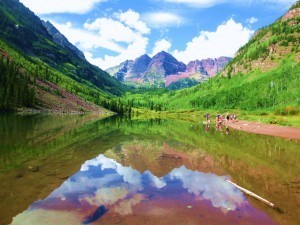 It took me nearly fifty years to finally take the five minute walk to the Maroon Bells, a destination that had been on my bucket list for over two decades. But what made this particular journey to see the twin peaks of Elk Mountain even more special, was the twelve year old boy who was playing in the mud puddles next to me, while happily munching on a dandelion.
It took me nearly fifty years to finally take the five minute walk to the Maroon Bells, a destination that had been on my bucket list for over two decades. But what made this particular journey to see the twin peaks of Elk Mountain even more special, was the twelve year old boy who was playing in the mud puddles next to me, while happily munching on a dandelion.
“Would you like some?” Mark asked, handing me a fist full of flowers.
“No thanks, but you better eat those quick before the park rangers see you,” I warned him.
Mark has cerebral palsy as a result of being born premature, which mostly affects his left leg and his ability to walk long distances or on difficult trails. He was wearing sheepskin Ugg boots to cushion his feet and suffers every day from some degree of pain, either in his feet or elsewhere in his body. He will tell you when he can’t walk anymore, but he always tries to walk as far as his feet will take him. Today, he had it easy. Our hike around Colorado’s most photographed peaks would be a short one.
Located just twelve miles southwest of Aspen, the Bells are also known as the “Deadly Bells” after eight climbers were killed in 1965. However for those wishing to simply hike around the area, access is shockingly easy. How many times had I admired the stunning images of the Maroon Bells, never imagining that they were literally only a short stroll from the car park?
People from all walks of life were heading alongside us toward the Mecca of Mountains. On the paved trail were people in wheelchairs, a group of bicyclists, a Chinese clan, a lady carrying her rollerblades and beagles busily sniffing at every bush in sight. Off in the distance, a young girl was learning how to fly fish, casting her line over and over into the glassy calm waters of Maroon Lake.
The panoramic view of the high purple peaks reaching upward toward the bluest of skies and reflected in the lakefront, takes your breath away. If ever there was a place that inspires awe and majesty and everything that is good in life, than it is there. You immediately feel the power of creation, gloriously painted across the purple and red mountainous landscape, enveloping every aspen grove and white dandelion field below. You feel humbled and happy to be alive and grateful that such a visually striking place even exists.
The grandeur surrounding us was in stark contrast from the topic of conversation that Mark and I had engaged in previously, while riding on the shuttle bus up to Bells. We had been talking about history and politics, (two of Mark’s most favorite subjects) and discussing the crisis in Syria. Not the typical conversation that you generally have with a twelve year old, but Mark is far from typical and has a mind as bold and as awe-inspiring as the mountains that we were admiring.
Mark was born in Singapore and has undergone daily therapy for most of his young life. He knows he is unique, which is both a blessing and a curse. His ever inquisitive mind, tirelessly seeks meaning and facts about the mysterious world around him and this sadly does set him apart – especially from kids his age. But on our enchanting hike underneath the shadow of the Bells, the history of the world and the politics of war, along with all the daunting facts and data stored in Mark’s brilliant mind fell away, taken over by a place that inspires something that we all seek; happiness and peace of mind. For more than five minutes in the refuge of Maroon Bells, we were both in heaven. Eating flowers and stomping in mud puddles.
The End
About the Author: Prisana Nuechterlein has flown in an ancient Russian helicopter in Laos, hitched hiked on the back of a coconut truck in Mindanao, and nearly boxed with sharks in the Similan Islands. A veteran traveler, her far flung adventures have been published in the Asian Wall Street Journal, The Bangkok Post, The Straits Times, Sawasdee Magazine (Thai International Airlines Magazine), The Phuket Gazette, Action Asia and numerous other publications. Visit her new travel blog.
The post Colorado: A Five Minute Walk to Heaven appeared first on We Said Go Travel.
September 26, 2013
Myanmar: Hindu Festival and Rainbow Restaurant (video)
WATCH: 42 Mandalay at night Hindu Festival and Rainbow Restaurant, Myanmar (Burma)
http://www.wesaidgotravel.com/ We Said Go Travel October 24, 2012 We were invited to participate at the Shree Ambika Hindu Temple for the last night of a festival. We thought Durga was returning to Shiva. But then we learned the row of cars was taking Shiva back to the river. I liked the girls in high heels and the energetic dancing!
We ate for the last time at Rainbow restaurant in Mandalay. Our favorite place to eat. Check it out! It is full of local men, very few women out and about at night here but many at the festival. Twenty seven days in Myanmar and 42 movies later, it is time to go back to Thailand.
This movie is from our 28 days in Myanmar (Burma) from September 28, 2012 to October 26, 2012 and our year TRIP in South East Asia, see all the videos from our trip: http://www.youtube.com/playlist?list=...
Our Memoir, Traveling in Sin, is available on Amazon.
Traveling in Sin is a HOT NEW Release on Amazon! from Lisa Niver Rajna
Traveling in Sin is a true tale of TRANSFORMATION thought LOVE and TRAVEL! After meeting online (on two different sites), George and Lisa travel internationally, give up their jobs, condo, ice cream and toilet paper in search of adventure and love. Along the way, Lisa sheds over 60 pounds and the couple gets engaged underwater in Thailand. There are tears, twists and true love!
Recent Press:
By Amy Sommer on Westside Today
By Dani Stone on Diets in Review
The post Myanmar: Hindu Festival and Rainbow Restaurant (video) appeared first on We Said Go Travel.
How to Make Friends While Traveling Solo
Most people who travel alone will tell you that they couldn’t imagine traveling in any other way, and they’re the kind of people that thrive on being by themselves. However, it’s a simple fact of life that people do need other people, and even the most independent of solo traveler knows that they need company every now and again.
If you’re not used to traveling alone, making friends on the road can be a very alien concept and seem impossible before you set out on your trip. However, with more experience and confidence building up as you go, meeting new people while going it alone isn’t actually as hard as it sounds. Here are a few tips to get you started out on being a solo travel social butterfly.
Pick your accommodation wisely
There are styles of accommodation that will make it really hard to meet people, and places where you’ll meet so many people that you’ll find it difficult to keep up with it all. If you stay in a regular hotel, a place that doesn’t have much of a social atmosphere to it, it can make it more difficult to talk to people. I find the kinds of travelers who stay in places like these are ones who like to keep themselves to themselves, which of course has a time and a place, but if you want to meet people there are better options out there.
Hostels, on the other hand, are completely the opposite, and the perfect place to stay if you’re looking to meet other travelers and people to hang out with. Use hostel comparison websites and reviews to figure out where the most popular hostels are, and you’ll be making friends from the moment you step in the door.
Figuring out what kind of accommodation is best for you to meet people in is step number one towards meeting people whilst traveling alone, so putting in the research here will definitely pay off.
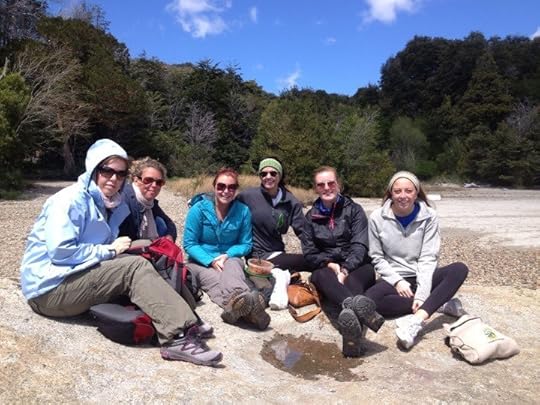
With a new group of friends from a hostel I was at in San Carlos de Bariloche, Argentina
Be confident
Confidence isn’t something that comes naturally to everyone, but when you’re traveling alone you sometimes need to throw yourself out of your comfort zone in order to get the most out of the experience. One element of this involves plucking up the courage to talk to new people, and even though it might sound like a daunting prospect at first, once you’ve traveled alone for a while it becomes much easier to be able to do this.
If you’re staying in a hostel, it’s incredibly easy to start talking to someone, and I’ve always said that’s one of the main things I love about hostels – they’re one of the very few places on the planet where it’s completely acceptable to strike up a conversation with the person sat next to you, and it in no way comes off as creepy. Make the most of having travelers around you, and chat to other people who might be traveling alone as they will be equally grateful for the company.
Get involved with Couchsurfing
Staying in a hostel isn’t the only way to meet people while traveling solo, of course, and websites such as Couchsurfing have revolutionised the way people get social whilst traveling. If you don’t fancy meeting a whole load of other travelers and would prefer to mingle with the locals, why not try your hand at Couchsurfing. This website connects travelers with locals and offers accommodation with a local to those people passing through the city.
Not only could you use it for finding a place to stay, Couchsurfing has also become a great way for travelers to connect through social events. Many cities have a weekly Couchsurfing meet-up, so always take a look through the events board for your destination on the Couchsurfing website to see if anything is going on during the time you’re there. The kind of people that use Couchsurfing are the kind that are willing to talk to anyone and everyone, and the open community it provides is perfect for the solo traveler looking to make new friends.

Me (far right) with Couchsurfing friends in Seattle
Take a tour, learn a language, and get social
Making friends while traveling solo essentially just involves putting yourself in the situation where you interact with others through a shared interest or activity. Taking a tour is one way to get chatting to other people, or signing up for a few language classes is another. Those are just two examples of things you could do to put yourself in a social situation, and I have found both to be very effective for making friends whilst on the road.
Sometimes making friends whilst traveling solo can really take you out of your comfort zone, but it’s something that comes naturally with more practice. Give yourself a little push each day to talk to someone new, and before you know it you’ll have friends all over the world.
About the author: Emma Higgins has been writing/traveling on and off since 2009. Her blog, Gotta Keep Movin’, is full of stories and advice from her trips, which include Europe, India, Morocco, South America, USA and Canada.
The post How to Make Friends While Traveling Solo appeared first on We Said Go Travel.
Oahu: Oct 3rd Travel Talk Story
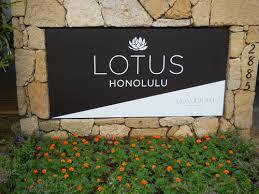 Travel Talk Story with We Said Go Travel:
Living without Regret
Travel Talk Story with We Said Go Travel:
Living without Regret
Have you dreamed of long-term international travels across Asia? Considered quitting your job to become a travel blogger and book writer? Want to connect with travel-minded community members?
Festival of the Pacific is a celebration of travel and transformation hosted by We Said Go Travel. The theme, “Living Without Regret: Travel, Love and Success: Make your Dreams a Reality”, presented by the founders of We Said Go Travel, Penn graduate Lisa Niver Rajna (C’89) and her husband George Rajna, will give an inside look into long-term exotic international travel across Asia. They will share their travel expertise, read an excerpt from their new memoir, “Traveling in Sin,” and provide information about We Said Go Travel’s writing contest, and upcoming community.
Join us for an evening of Travel Talk Story with Lisa and George, network with the travel community, and enjoy hosted pupus and drinks. There will be goodie bags for all attendees and raffle prizes.
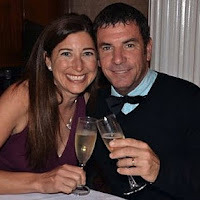
Mahalo to our Sponsors:
Lotus Honolulu for providing the venue space. Book your stay at Aqua Lotus Honolulu for a peaceful retreat steps away from the beach, Kapiolani Park, and Diamond Head. The hotel decor is Bali-fusion inspired with Hawaiian warm hospitality. Aqua Lotus Honolulu amenities include in-room high speed Internet & WiFi, safe, complimentary coffee and tea service in the lobby, daily local newspaper, valet and concierge services, banquet/meeting facilities and complimentary use of beach items such as sand chairs, umbrellas and mats for the beach just steps away. Lotus Honolulu’s Facebook Page / @LotusHonolulu
Park Restaurant for hosting pupus. Park Restaurant uses fresh local ingredients. The food will take you on a culinary journey of infused flavors borrowed from French and Italian, to Greek and Egyptian influences. Chef Collantes’ menu promises a dining experience that is as much adventurous as it is comforting. Park Restauurant Waikiki’s Facebook Page / @ParkHawaii
Zaratez Mexicatessen for donating to the raffle prizes. Dine at the restaurant for home style taqueria including tacos, burritos and quesadillas. Zaratez Mexicatessen’s Facebook Page / @zaratez
Uber Honolulu for providing sleek black car service for attendees to this event. Sign up for Uber by downloading the app (on iPhone and Android) and request your black car service on the event day. Uber’s Facebook Page / @Uber
Gogobot Oahu for collaborating with We Said Go Travel. Download the Gogobot travel app (on iPhone and Android) and join the millions of travel community members in reviewing and sharing travel experiences and postcards. Gogobot Oahu’s Facebook Page / @GogobotOahu
PLEASE RSVP: CLICK HERE

The post Oahu: Oct 3rd Travel Talk Story appeared first on We Said Go Travel.
September 25, 2013
Thailand: Have You Been Spotified?
 Before departing to Asia for the year, I dutifully loaded my ipod with hundreds of songs to accompany me overseas. I deemed my decision prudent, in that I would be armed with a variety of music from genres diverse as heavy metal, bebop jazz, and hip hop music. However, three months into our trip, I began to find it difficult to find tunes that I was excited about, and two months later, I barely listened to my ipod at all. Not only was I growing tired of my playlist, but I yearned to listen to music that I heard while traveling. I did not wish to haul around CDs or purchase a CD-ROM drive so I could upload purchased songs onto my computer hard drive.
Before departing to Asia for the year, I dutifully loaded my ipod with hundreds of songs to accompany me overseas. I deemed my decision prudent, in that I would be armed with a variety of music from genres diverse as heavy metal, bebop jazz, and hip hop music. However, three months into our trip, I began to find it difficult to find tunes that I was excited about, and two months later, I barely listened to my ipod at all. Not only was I growing tired of my playlist, but I yearned to listen to music that I heard while traveling. I did not wish to haul around CDs or purchase a CD-ROM drive so I could upload purchased songs onto my computer hard drive.
I wasn’t until Langtang, Nepal during a trek in the high Himalayan mountains did I learn of Spotify. We reached a small family run guesthouse with only two total rooms available and one shared outdoor bathroom. The other room was occupied by three Swedes. One of them listened to music on his phone that blared from a mini speaker. When I asked how many songs he could store on his phone he explained that he had downloaded some of his songs from Spotify but the majority of his collection was simply cloud based. I learned that a mere $5usd investment per month would permit me to have new music at my fingertips. I couldn’t wait to sign-up for the premium Spotify service and begin downloading my favorite tunes. However, I had to be patient. We were in the high mountains over 3,000 meters in elevation where wifi and Internet access were absent or severely limited.
When we returned to Nepal’s capitol, Kathmandu, I immediately attempted to download Spotify. To my dismay a message indicated that I was unable to use Spotify in my country of origin. I was once again forced to wait until we reached Malaysia ten days later. In Kuala Lumpur, I was able to download the application and within minutes I enjoyed songs on my computer and mobile devices; the software was simple and intuitive to operate. Within days I had hundreds of new songs to listen to on my devices. My wife even set up a separate “disco playlist” that she listened to while hula hooping.
Within a month, I had downloaded well over 1,500 songs onto my Spotify account that easily transferred to all of my mobile devices. Not everything was perfect, however. I could not find a band from the 1990s named “Adorable” and a few major artists such as “The Beatles” and “Pink Floyd” are not readily available although some of their songs can be listened to when they appearing on multi-artist CD compilations. In addition, some songs are poor quality demos and mediocre live recordings rather than the original recordings; still, these lesser tracks are rare in occurrence, in less than one percent of total available recordings.
All in all I am an extremely content member of the Spotify community. Spotify has become my main source of music where I daily download tunes from a variety of genres. In fact, I have been reading Pete Townsend’s new autobiography where he lists many of his earlier influences and I have used Spotify to download his recommendations in real time as I read the book. So if you have not yet been Spotified, take the free 30-day trial and you will be instantly hooked!
WATCH: Koh Samui Rock Island House Band where George played twice a week!
George Rajna, MBA, MS Communications Disorders, is a bilingual speech therapist who has traveled to 100 countries across six continents. He composes music on the guitar and ukulele, and spent two years working in rural education for Peace Corps Paraguay. He is a Huffington Post Blogger and is currently editing the tales of their first sabbatical while in Asia on sabbatical #2. His favorite region is South East Asia and he recommends Bagan (Burma/Myanmar), Koh Lipe (Thailand/engagement), Angkor Temples (Cambodia), Langzong (China), diving in Sipandan (Malaysia), and trekking in Nepal. Learn more about George at Wikipedia-click here.
The post Thailand: Have You Been Spotified? appeared first on We Said Go Travel.
Cambodia: Three Days in Phnom Penh
Even the weather was perfect-cloudy skies, a cool breeze and little rain. As the plane flew over the rice fields of Cambodia, dipping through clouds and finally emerging over the confluence of the Mekong and the Tonle rivers over Phnom Penh, I gazed at the flying countryside and city below, not just a little amazed at the fact that I was actually here.
No one really thinks of Phnom Penh as a tourist destination in itself-a city with essentially no landmark sights and a reportedly high crime rate. The city, however, had come alive for me just a few days into reading its history and its place in the Khmer Rouge Revolution of 1975-1979. Riveting accounts of the events of April 1975 had geographical references to the city that still exist. And of course, there was the torture prison known as S21 and the related “Killing Fields” of Choeung Ek, both symbols of the Khmer Rouge and now museums in the city. As I read more about the Cambodian Holocaust, it became obvious to me that practically every living Cambodian is either a direct or indirect victim of the Khmer Rouge era.
I came with simple plans of seeing S21 and Choeung Ek but I ended up with a glimpse of the soul of a country and a people I had read much about. I went to relive history but I also ended up falling in love with a city and the warmth, genuiness and smiles of practically everyone I met. As the Sun dipped below the horizon, I sat on a waterfront bench and gazed out at the banks of the mighty Mekong where many a battle had been fought and just saw a normal city, a people going about their lives-children playing by the waterfront, bars and pubs open for business, a beggar sitting by the roadside, monks emerging from a Wat.
Thun-an unfailingly polite, always punctual, gentle man, was my tuk tuk driver on all my little trips in Phnom Penh. On many occassions, as we passed the sights, back roads and boulevards of a city once called “Paris of the East”, I could not escape the feeling that the two of us were in a cocoon, looking at a city and a culture from the outside in. I felt myself changing into a privileged observer, interacting with the people and the institutions that define them and then respectfully withdrawing, and Thun was my unwitting partner, waiting patiently by his tuk tuk, while I took my time and indulged my fantasies.
Over the course of my three day trip, I discovered a warmth that once was-before war and politics tore Cambodia apart and I saw that in Thun, in the staff of my hotel who made me feel like family and in the many ordinary Cambodians I was previlged to interact with- living normal lives, trying to forget a past that may be impossible to move away from. I felt the sorrow of those years still alive in an old roadside bookseller whose handshake and smile are indelible memories, in my guide at S21 who shared her tragic life story and in the S21 survivors whose lips part in an obligatory smile for a photo but whose eyes cannot hide their pain.
When you get stuck in traffic in Phnom Penh, imagine the city completely abandoned, empty and quiet. Pass by the Gate of the French Embassy and while you swerve to avoid incoming traffic, try to imagine the desperation and chaos of April 1975. Ask yourself why you hardly see anyone who looks older than 50. And when you do, don’t think too much about what they were doing for the worst four years anywhere in recent history.
On my last evening in the city, I walked across to a nearby roadside cafe, right across the road from Wat Lanka. Sitting there, my mind empty of thoughts, I heard the chime of bells from the temple. The evening was cool and subdued rock played on the stereo. Some mild traffic passed by, mainly tuk tuks looking for a ride. I sat alone next to a group of “barangs” (expats) and watched as a small girl skipped in with a bunch of flowers. And I watched transfixed as the girl and the barangs bonded and chatted in pure Khmer like old friends. They did not buy the flowers but the girl’s smile never left her face.
These are the memories I carry and the images that play on my mind.
I went as a tourist and returned with sheer respect and gratitude for a country that must be visited to be truly appreciated.
Cambodia will not be a one time visit but it was a once in a lifetime experience.
About the Author: Nishikanta Verma: I am an Indian doctor currently residing in Malaysia. I am passionate about all things related to Cambodia and also have current interests in World History, Buddhism and Quantum Physics. I am married with one daughter and another on the way. Twitter: @jipmerdays.
The post Cambodia: Three Days in Phnom Penh appeared first on We Said Go Travel.
September 24, 2013
Sri Lanka: The Footprint Atop the Earth
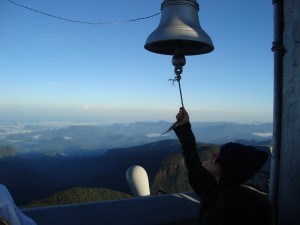 In 2009, shortly after my seventeenth birthday, I found myself at the top of the world gazing over Eden.
In 2009, shortly after my seventeenth birthday, I found myself at the top of the world gazing over Eden.
I was living in Sri Lanka, and on being asked if I wanted to climb Sri Pada (also known as Adam’s Peak), I was never going to say no. Sri Pada is a mountain with a history and religious significance appreciated around the world. It is specifically renowned for the giant footprint, nearing six feet in length, embedded at its peak, the origin of which is disputed but widely revered. Buddhists believe it to be the footprint of Buddha, Hindus of Shiva, and Christians and Muslims believe it to be the footprint of Adam when he first stepped onto Earth.
On the day of our climb, I got home from school, packed my bags and was ready to make the four hour drive to Muskeliya, from which we would head on to the foot of the mountain. I was accompanied by my close friend, George, who had done this trek twelve times before. We set off at two thirty in the morning, leaving about four hours to make it up the mountain before sunrise. I was nervous. I had stupidly not slept or eaten before embarking on this endeavour and I was not an especially fit person. The steps were steep and seemingly endless and I was repelled by the idea of not being able to make it up; of having to sit on the stairs, shame-faced, waiting for the others to return. But George was my veteran and stuck by my side the whole way, promising I would make it up before sunrise, no doubt. And in the end, I did.
We found a place to sit atop an old derelict building, squashed between tourists and pilgrims alike, and awaited the sunrise together in the cold, crisp air. Music blared out of speakers; the sounds of prayer and homage. When the sun peaked over the far distant hills and lit the valleys below, I felt the breath catch in my throat. It was beyond what I had expected, and after that miserable upward journey, I had expected a lot. The lakes shone silver and the clouds burst into flame. There was a total calmness to it, an absolute tranquillity. I felt detached from reality, like I finally understood T.S. Eliot’s line about being ‘at the still point of the turning world.’
Now admittedly, I’d spent the majority of my life declaring myself entirely faithless, but when I was up there, watching the sun rise over the mountains and gazing down at the valleys and lakes so far below me, I believed every one of those stories. It was more than possible to me that I was standing in Eden and that I was viewing the world from the point where the first human viewed it. That the giant footprint had indeed been made by Buddha and by Adam and by Shiva. That Sri Lanka was the garden of Eden and the birthplace of all humanity. Nothing seemed so plausible.
When we finally tore ourselves from the sunrise, we turned to the North-West side of the mountain to experience Sri Pada’s other famous landmark; it’s shadow. The shadow of Sri Pada is unique in that it no way resembles the shape of the mountain. It falls across the forests as a perfect pyramid, its two sides forming eerily straight lights tapering to a point that doesn’t exist on the actual mountain, which is rounded and misshaped. Scientists don’t understand it, nobody seems able to explain it. Yet somehow it just fits into the overall mystique and miraculous atmosphere of the ancient mountain.
With the sunset, the shadow and the footstep behind us, we turned to the last site Sri Pada had to offer; the bell that travellers can ring, once for every time they’ve made the climb. I rang it once proudly, feeling it was an apt representation of the triumph I felt. Then my friend George went and rang it thirteen times, much to the surprise of the crowd who couldn’t believe he had climbed the peak that many times and thought he had simply misunderstood the bell’s meaning.
Then, the descent. Most of the people I know informed me that going down was far more painful than going up as it’s harder on your leg muscles. Well, I pretty much ran down that mountain without feeling a thing. I was elated. Ecstatic. I’d made it to the top, I’d seen the sunrise and the shadow, and I felt in-vinc-ible. Sadly, this mentality died almost the second I reached home. My legs turned to jelly and I was literally unable to stand for two days. But oh well. No matter. I’d seen the face of Eden… and it was glorious.
About the Author: Angeleen Renker is a 20 year old aspiring writer. She plans on spending the rest of her life drinking gin, travelling to far off lands and trying to read as many books as humanly possible. She also hopes you have a truly splendid day.
The post Sri Lanka: The Footprint Atop the Earth appeared first on We Said Go Travel.
September 23, 2013
Is Flying Always Preferable to Overland Travel?
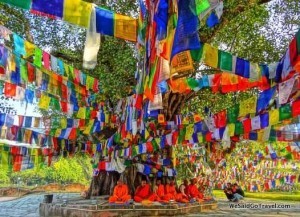
Lumbini, Nepal
Is Flying Always Preferable to Overland Travel?
by George Rajna
When traveling abroad, the majority of travelers fly between locations with the obvious advantages of speed and convenience despite the far higher costs associated with air transportation. Even though air flights have advantages, going overland between countries can lead to visiting locales that are often overlooked because they are inconvenient to travel to from airports of capital cities.
My wife, Lisa Niver Rajna, and I have been traveling in Asia since July 2012 for well over a year. During our travels throughout countries such as Indonesia, Thailand, Malaysia, India, and Nepal, we use public land transport to meet the majority of our transport needs. As a general rule, we avoid air transport if the trip by land is less than eight hours. The reasoning is that quite a few preparatory hours are necessary to be able to fly. Airports are generally located far out of town both in the departing and arriving cities. Also, people flying must arrive to the airport at least two hours in advance. Therefore, the minimum time necessary to prepare to fly and transfer to the arriving city hotel will take a minimum of four hours, not including flight time. Hence, it makes sense to fly only when land travel time substantially exceeds the time it takes to prepare for and take the flight.
However, even when travel time by land is extensive, the reward of visiting sites and remote towns can easily outweigh the convenience of a flight. For example, while traveling from India to Nepal, we were easily able to reach Buddha’s place of birth, Lumbini, since we arrived by land rather than the distant airport in Kathmandu. A structure that houses a stone marks the spot where Buddha was actually conceived. From Lumbini, we headed to Tansen – an authentic, non-touristy town – situated near a variety of day hike trails. The friendly local people were sincere and curious about international travelers. School children and young adults frequently struck up conversations at restaurants and other establishments that cater to both locals and tourists.
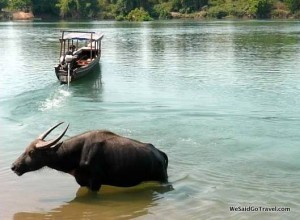
Don Det, Laos
Another example of advantageous overland travel occurred when we traveled by land between the countries of Laos and Cambodia in South-east Asia. The Laos side boasts beautiful scenic jungle islands including Don Det.; this remote island is home to lush jungle, water buffalos and friendly children. In the tropical climate, floating downriver in inner tubes is a pleasant way to spend the afternoon. Not far from the Cambodian side of the boarder is the town of Kratie, famous for viewing the pink river dolphin.
In addition to opening possibilities of traveling to out of the way destinations when traveling overland, travelers are literally able to feel the change from one country to the next as it actually occurs. For example, when we departed India after having traveled there for three months, our arrival by land to the Nepali boarder town Bhairawa located only perhaps ten kilometers from India, was a world away in the manner that people interacted, with an evident and tangible change in the local culture.
Of course, flying between destinations using air transportation has its place in both domestic and international travel. However, with an open mind, time, and a sense of adventure, travelers can take advantage of cheaper land transport to save money and see worthwhile sites at the same time.
The post Is Flying Always Preferable to Overland Travel? appeared first on We Said Go Travel.
September 22, 2013
Asia: A Traveling Chalkboard Champion
 Lisa Niver Rajna: The Chalkboard Champion Who Teaches Her Students That Science and Geography Isn’t Scary
Lisa Niver Rajna: The Chalkboard Champion Who Teaches Her Students That Science and Geography Isn’t ScaryLisa Niver Rajna, an elementary science teacher from Los Angeles, California, is an amazing chalkboard champion. Lisa was born in Boston, Massachusetts in 1967, and earned her master’s degree in education from the University of Pennsylvania. In addition to her career as a professional educator, she is also a sought-after motivational speaker, travel agent, and travel writer.
Lisa is well-known in science teacher circles for her instructional strategies that emphasize her students use technology and real world connections to explore their passions and to work towards solving today’s most complex issues. She has also developed a successful summer science camp for students and maintains a science-based web site entitled Science Isn’t Scary. In 2009, Lisa founded the Los Angeles Science Teachers Network (LASTN), a professional development network that by May, 2012, involved over seventy teachers and forty schools. The effort has been praised by the Bill and Melinda Gates Foundation.
Lisa Niver Rajna has published many articles in online and offline magazines, includingNational Geographic, The Huffington Post, The Guardian, and The Jewish Journal. She was a 2012 nominee for the Presidential Awards for Excellence in Math and Science Teaching.
Here is a link to her educational web site: Science Isn’t Scary
Here is a link to her travel web site: We Said Go Travel
The post Asia: A Traveling Chalkboard Champion appeared first on We Said Go Travel.
We Said Go Travel
We Said Go Travel is a global community of over sixteen hundred writers with articles from every continent.
Stories are shared with photos and video from a perspective of the transformative power of travel. We Said Go Travel has hosted live and online events as well as travel writing contests around the world. ...more
- Lisa Niver's profile
- 57 followers


